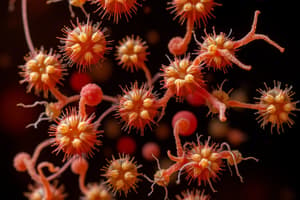Podcast
Questions and Answers
Which of the following mechanisms is NOT typically employed by bacteria to cause disease?
Which of the following mechanisms is NOT typically employed by bacteria to cause disease?
- Produce toxins
- Secrete enzymes that damage host tissues (correct)
- Invade tissues
- Evade immune responses
Which beneficial microorganism is known for its role in nitrogen-fixing?
Which beneficial microorganism is known for its role in nitrogen-fixing?
- Lactobacillus
- Penicillium
- Rhizobium (correct)
- Saccharomyces
What is a common method for preventing the transmission of pathogenic microorganisms?
What is a common method for preventing the transmission of pathogenic microorganisms?
- Using antibiotics indiscriminately
- Increasing direct contact with infected individuals
- Ignoring proper food handling practices
- Vaccine development (correct)
Which type of microorganism is primarily recognized for its role in bioremediation?
Which type of microorganism is primarily recognized for its role in bioremediation?
Which of the following roles is performed by algae?
Which of the following roles is performed by algae?
Flashcards are hidden until you start studying
Study Notes
Microorganisms
Pathogenic Microorganisms
- Definition: Organisms that can cause disease in a host.
- Types:
- Bacteria:
- Examples: Streptococcus, Staphylococcus, E. coli
- Mechanisms: Produce toxins, invade tissues, evade immune responses.
- Viruses:
- Examples: Influenza, HIV, Hepatitis
- Mechanisms: Invade host cells, replicate using host machinery, cause cell damage.
- Fungi:
- Examples: Candida, Aspergillus
- Mechanisms: Can cause infections in immunocompromised hosts, secrete enzymes that damage host tissues.
- Parasites:
- Examples: Plasmodium (malaria), Giardia
- Mechanisms: Live off host nutrients, can cause lasting damage or interfere with bodily functions.
- Bacteria:
- Transmission:
- Direct contact, air, water, vectors (insects), and through contaminated food.
- Prevention:
- Vaccination, hygiene practices, sanitation, and proper food handling.
Beneficial Microorganisms
- Definition: Microorganisms that provide beneficial effects for humans, animals, or the environment.
- Types:
- Bacteria:
- Examples: Lactobacillus (probiotics), Rhizobium (nitrogen-fixing)
- Functions: Aid in digestion, synthesize vitamins, improve soil fertility.
- Fungi:
- Examples: Saccharomyces (yeast), Penicillium (antibiotic production)
- Functions: Fermentation in food production, bioremediation, and decomposition of organic matter.
- Algae:
- Functions: Produce oxygen, form the base of aquatic food chains, biofuel production.
- Viruses (phages):
- Functions: Can be used to target and kill pathogenic bacteria, potential use in phage therapy.
- Bacteria:
- Applications:
- Food industry: Fermented foods like yogurt, cheese, and sauerkraut.
- Medicine: Antibiotics, vaccines, and probiotic supplements.
- Environmental: Bioremediation for pollution control, biofertilizers in agriculture.
Pathogenic Microorganisms
- Disease-causing organisms.
- Bacteria: Streptococcus, Staphylococcus, E.coli cause disease by producing toxins, invading tissues, and evading immune responses.
- Viruses: Influenza, HIV, and Hepatitis invade host cells, replicate using host machinery, and cause cell damage.
- Fungi: Candida and Aspergillus can cause infections in immunocompromised hosts and secrete enzymes that damage host tissues.
- Parasites: Plasmodium (malaria) and Giardia live off host nutrients and can cause lasting damage or interfere with bodily functions.
- Spread through direct contact, air, water, vectors (insects), and contaminated food.
- Prevention measures include vaccination, hygiene practices, sanitation, and proper food handling.
Beneficial Microorganisms
- Microorganisms that provide benefits to humans, animals, or the environment.
- Bacteria: Lactobacillus (probiotics) aid in digestion and synthesize vitamins, while Rhizobium improves soil fertility through nitrogen fixation.
- Fungi: Saccharomyces (yeast) is used in food production through fermentation, Penicillium produces antibiotics, and fungi contribute to decomposition of organic matter.
- Algae produce oxygen, form the base of aquatic food chains, and are used in biofuel production.
- Viruses (phages) can target and kill pathogenic bacteria, with potential applications in phage therapy.
- Applications:
- Food industry: Fermented foods like yogurt, cheese, and sauerkraut.
- Medicine: Antibiotics, vaccines, and probiotic supplements.
- Environmental: Bioremediation for pollution control and biofertilizers in agriculture.
Studying That Suits You
Use AI to generate personalized quizzes and flashcards to suit your learning preferences.




